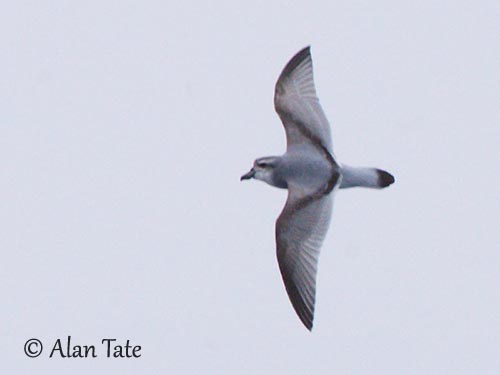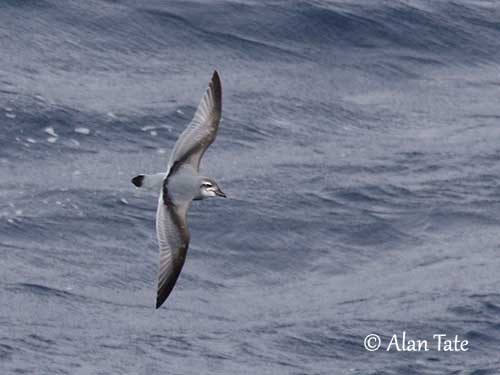
Fr: Prion de Forster
Ang: Broad-billed Prion
All: Großer Entensturmvogel
Esp: Prión piquiancho
Ita: Prione beccolargo
Nd: Breedbekprion
Sd: Brednäbbad valfågel
Photographers:
Simon Tan
PBase Bird galleries
Alan & Ann Tate
AA Bird Photography
Text by Nicole Bouglouan
Sources:
HANDBOOK OF THE BIRDS OF THE WORLD vol 1 by Josep del Hoyo-Andrew Elliot-Jordi Sargatal - Lynx Edicions - ISBN: 8487334105
A Complete Guide to Antarctic Wildlife by Hadoram Shirihai and Illustrated by Brett Jarrett - Edited by Guy M. Kirwan - ALUL.A Press Oy, Finland - ISBN 9519894705
New Zealand birds and birding (Narena Olliver)
Wikipedia, the free encyclopaedia
Burrow competition between Chatham petrels and broad-billed prions
By Phillipa Gardner & Kerry-Jayne Wilson
Page family Procellariidae
Summary cards
Broad-billed Prion
Pachyptila vittata
Procellariiformes Order – Procellariidae Family
INTRODUCTION:
The Broad-Billed Prion is very similar in appearance to other prions found in the Southern Ocean. They have a peculiar morphological feature that makes them slightly different from other Procellariidae. They have a disproportionately large, very broad-based, black bill and high forehead. The bill is well-adapted to their feeding behaviour, allowing the birds to filter the seawater and to get minute marine organisms.
The typical dark M is well visible on the upperparts when the bird is flying. It is the largest prion species with a length of 28 centimetres.
Like numerous Procellariidae, the Broad-Billed Prion is threatened by introduced predators on its breeding islands, and the population is progressively declining.

DESCRIPTION DE L’OISEAU:
Biometrics:
Length: 28 cm
Wingspan: 57-66 cm
Weight: 200 gr (in average)
The adult has blue-grey upperparts with the typical black M on the upperwing. The tail shows broad black tip and paler sides.
The underparts are white, including underwing and undertail, except a dark area on central tail, and dark webs to outer primaries. The breast sides are dusky grey, almost forming a collar in some birds, and involving dark-hooded appearance.
On the dark head, we can see a narrow, white supercilium confined to above and behind the eye. A dark stripe extending from around the lower eye to the ear-coverts, contrasts with the white supercilium. Lores are greyish-white, less white than in other prions.
The Broad-Billed Prion has heavy, broad-based bill and steep forehead. The bill is dark grey with black culmen. It shows a special adaptation for feeding on minute marine organisms, a fringe of comb-like filters around the upper mandible. In addition, the muscular tongue forces the water out through the lamellae. There is a distensible pouch between the bowed lower mandible and the tongue. This pouch allows the bird to carry food.
The eyes are blackish. Legs and webbed feet are bluish to dark grey, with greyer or tinged flesh webs.
Male and female are similar.
The juvenile resembles adult, but the dark M-shaped marking is duller and browner. The upperparts are duller grey too.
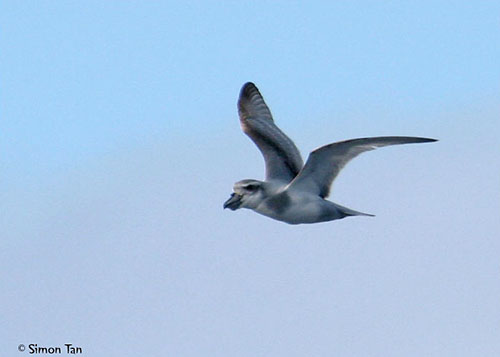
RANGE:
The Broad-Billed Prion is found in subantarctic and subtropical seas, from SE Atlantic to New Zealand. It breeds on several subantarctic islands, in S South Island (New Zealand) and islets off Stewart Island, Snares Islands and Chatham Islands, Tristan da Cunha and Gough Island.
HABITAT:
The Broad-Billed Prion is a pelagic seabird which comes to land only for breeding. It nests on coastal slopes and steep banks, in ferns and low forests, on flat lava fields, on cliffs and between rocks and caves.
CALLS AND SONGS: SOUNDS BY XENO-CANTO
The Broad-Billed Prion is usually silent at sea. It becomes more vocal at night at colonies where it produces harsh chattering and softer cooing. The males utter varied sounds, the most usual are “pop poor popper pop” and a rattling “per-per-per-per”. The alarm call is a shrill “pihihihi”.
A “wall of sound” may merge from dense colonies.
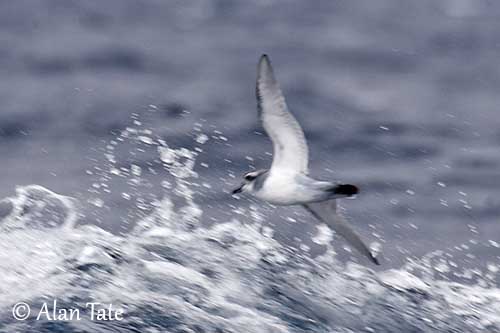
BEHAVIOUR IN THE WILD:
The Broad-Billed Prion feeds primarily on zooplankton, and mainly on copepods (small crustaceans). The seawater is filtered through the lamellae of the upper mandible. However, it also feeds on krill of genus Euphausia, amphipods, barnacles and small fish. Outside the breeding season, it often feeds on squid.
The preys are caught by hydroplaning. The bird in flight is facing the wing with extended wings to keep the balance. It dips head and neck into the water, about 10 centimetres under the surface. Other techniques such as surface-filtering, surface-seizing, surface-diving and dipping are used.
They are gregarious at sea, but they are not attracted by boats.
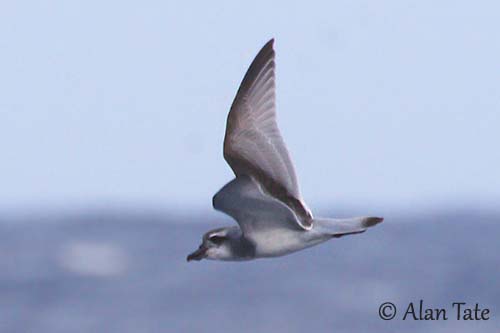
During the breeding season, most sexual activity takes place inside the burrow, with rather simple courtship behaviour. It consists usually of mutual preening and “billing” with oil dribbling down the bill. They may give some whistles or trills before or while mating, and may perform duets. They are aggressive around the nest, and defend a small area around the entrance.
The Broad-Billed Prion is known to kill the chicks of the Chatham Petrel in order to usurp their burrows for their own use. This competition for nest-sites is one of the main causes of decline of the latter species.
The adult remain in the waters around the colonies after breeding, and may visit them occasionally during winter. However, the young birds perform some dispersion and can be seen N to Australia and W South Africa. Some vagrants have been recorded off N Chile and S Peru, and Brazil too, off Rio Grande do Sul.
The Broad-Billed Prion has slower, less erratic flight than other prions, and it glides more than congeners. It is a good flier able to manoeuvre at great speed.
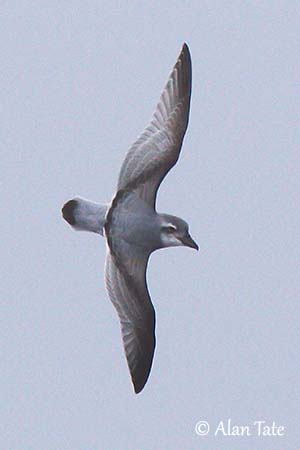
REPRODUCTION OF THIS SPECIES:
The breeding season starts in July/August. The birds perform a pre-laying exodus during several days, and the egg-laying occurs over three weeks between late August and mid-September. This period may vary according to the breeding islands and the range.
The Broad-Billed Prion excavates a burrow of 1-2 metres deep. It is lined with leaves, grass or twigs. The birds may occasionally use caves or rocky crevices.
The female lays a single white egg, and both adults incubate during 45-50 days, with shifts of 5-7 days. The chick is fed by regurgitation by both parents. They young bird leaves the colonies between mid-December and late January, about two months after hatching.
PROTECTION / THREATS / STATUS:
The Broad-Billed Prion is abundant on predator-free islands, but severe storms are responsible of mortality too. The Brown Skua kills numerous birds at many colonies.
The population was estimated at 15,000,000 individuals in 2004. Numbers are decreasing progressively.
But currently, the Broad-Billed Prion is evaluated as Least Concern.
